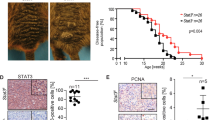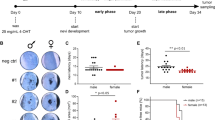Abstract
Melanoma is a dangerous form of skin cancer derived from the malignant transformation of melanocytes. The transcription factor SOX2 is not expressed in melanocytes, however, it has been shown to be differentially expressed between benign nevi and malignant melanomas and to be essential for melanoma stem cell maintenance and expansion in vitro and in xenograft models. By using a mouse model in which BRafV600E mutation cooperates with Pten loss to induce the development of metastatic melanoma, we investigated if Sox2 is required during the process of melanomagenesis, melanoma growth and metastasis and in the acquisition of resistance to BRAF inhibitors (BRAFi) treatments. We found that deletion of Sox2 specifically in Pten null and BRafV600E-expressing melanocytes did not prevent tumor formation and did not modify the temporal kinetics of melanoma occurrence compared to Sox2 wt mice. In addition, tumor growth was similar between Sox2 wt and Sox2 deleted (del) melanomas. By querying publicly available databases, we did not find statistically significant differences in SOX2 expression levels between benign nevi and melanomas, and analysis on two melanoma patient cohorts confirmed that Sox2 levels did not significantly change between primary and metastatic melanomas. Melanoma cell lines derived from both Sox2 genotypes showed a similar sensitivity to vemurafenib treatment and the same ability to develop vemurafenib resistance in long-term cultures. Development of vemurafenib resistance was not dependent on SOX2 expression also in human melanoma cell lines in vitro. Our findings exclude an oncogenic function for Sox2 during melanoma development and do not support a role for this transcription factor in the acquisition of resistance to BRAFi treatments.
This is a preview of subscription content, access via your institution
Access options
Subscribe to this journal
Receive 50 print issues and online access
$259.00 per year
only $5.18 per issue
Buy this article
- Purchase on Springer Link
- Instant access to full article PDF
Prices may be subject to local taxes which are calculated during checkout




Similar content being viewed by others
References
Kamachi Y, Uchikawa M, Kondoh H . Pairing SOX off: with partners in the regulation of embryonic development. Trends Genet 2000; 16: 182–187.
Avilion AA, Nicolis SK, Pevny LH, Perez L, Vivian N, Lovell-Badge R . Multipotent cell lineages in early mouse development depend on SOX2 function. Genes Dev 2003; 17: 126–140.
Campolo F, Gori M, Favaro R, Nicolis S, Pellegrini M, Botti F et al. Essential role of Sox2 for the establishment and maintenance of the germ cell line. Stem Cells 2013; 31: 1408–1421.
Sarkar A, Hochedlinger K . The sox family of transcription factors: versatile regulators of stem and progenitor cell fate. Cell Stem Cell 2013; 12: 15–30.
Irie N, Weinberger L, Tang WW, Kobayashi T, Viukov S, Manor YS et al. SOX17 is a critical specifier of human primordial germ cell fate. Cell 2015; 160: 253–268.
Wegner M . From head to toes: the multiple facets of Sox proteins. Nucleic Acids Res 1999; 27: 1409–1420.
Hussenet T, Dali S, Exinger J, Monga B, Jost B, Dembele D et al. SOX2 is an oncogene activated by recurrent 3q26.3 amplifications in human lung squamous cell carcinomas. PLoS One 2010; 5: e8960.
Toschi L, Finocchiaro G, Nguyen TT, Skokan MC, Giordano L, Gianoncelli L et al. Increased SOX2 gene copy number is associated with FGFR1 and PIK3CA gene gain in non-small cell lung cancer and predicts improved survival in early stage disease. PLoS One 2014; 9: e95303.
Rudin CM, Durinck S, Stawiski EW, Poirier JT, Modrusan Z, Shames DS et al. Comprehensive genomic analysis identifies SOX2 as a frequently amplified gene in small-cell lung cancer. Nat Genet 2012; 44: 1111–1116.
Bass AJ, Watanabe H, Mermel CH, Yu S, Perner S, Verhaak RG et al. SOX2 is an amplified lineage-survival oncogene in lung and esophageal squamous cell carcinomas. Nat Genet 2009; 41: 1238–1242.
Boumahdi S, Driessens G, Lapouge G, Rorive S, Nassar D, Le Mercier M et al. SOX2 controls tumour initiation and cancer stem-cell functions in squamous-cell carcinoma. Nature 2014; 511: 246–250.
Mukhopadhyay A, Berrett KC, Kc U, Clair PM, Pop SM, Carr SR et al. Sox2 cooperates with Lkb1 loss in a mouse model of squamous cell lung cancer. Cell Rep 2014; 8: 40–49.
Wilbertz T, Wagner P, Petersen K, Stiedl AC, Scheble VJ, Maier S et al. SOX2 gene amplification and protein overexpression are associated with better outcome in squamous cell lung cancer. Mod Pathol 2011; 24: 944–953.
Chen Y, Huang Y, Chen J, Wang S, Zhou J . The prognostic value of SOX2 expression in non-small cell lung cancer: a meta-analysis. PLoS One 2013; 8: e71140.
Otsubo T, Akiyama Y, Yanagihara K, Yuasa Y . SOX2 is frequently downregulated in gastric cancers and inhibits cell growth through cell-cycle arrest and apoptosis. Br J Cancer 2008; 98: 824–831.
Tsao H, Chin L, Garraway LA, Fisher DE . Melanoma: from mutations to medicine. Genes Dev 2012; 26: 1131–1155.
Miller AJ, Mihm MC Jr . Melanoma. N Engl J Med 2006; 355: 51–65.
Shinozaki M, Fujimoto A, Morton DL, Hoon DS . Incidence of BRAF oncogene mutation and clinical relevance for primary cutaneous melanomas. Clin Cancer Res 2004; 10: 1753–1757.
Lundberg IV, Lofgren Burstrom A, Edin S, Eklof V, Oberg A, Stenling R et al. SOX2 expression is regulated by BRAF and contributes to poor patient prognosis in colorectal cancer. PLoS One 2014; 9: e101957.
Laga AC, Zhan Q, Weishaupt C, Ma J, Frank MH, Murphy GF . SOX2 and nestin expression in human melanoma: an immunohistochemical and experimental study. Exp Dermatol 2011; 20: 339–345.
Laga AC, Lai CY, Zhan Q, Huang SJ, Velazquez EF, Yang Q et al. Expression of the embryonic stem cell transcription factor SOX2 in human skin: relevance to melanocyte and merkel cell biology. Am J Pathol 2010; 176: 903–913.
Girouard SD, Laga AC, Mihm MC, Scolyer RA, Thompson JF, Zhan Q et al. SOX2 contributes to melanoma cell invasion. Lab Invest 2012; 92: 362–370.
Santini R, Pietrobono S, Pandolfi S, Montagnani V, D'Amico M, Penachioni JY et al. SOX2 regulates self-renewal and tumorigenicity of human melanoma-initiating cells. Oncogene 2014; 33: 4697–4708.
Dankort D, Curley DP, Cartlidge RA, Nelson B, Karnezis AN, Damsky WE Jr et al. Braf(V600E) cooperates with Pten loss to induce metastatic melanoma. Nat Genet 2009; 41: 544–552.
Favaro R, Valotta M, Ferri AL, Latorre E, Mariani J, Giachino C et al. Hippocampal development and neural stem cell maintenance require Sox2-dependent regulation of Shh. Nat Neurosci 2009; 12: 1248–1256.
Bosenberg M, Muthusamy V, Curley DP, Wang Z, Hobbs C, Nelson B et al. Characterization of melanocyte-specific inducible Cre recombinase transgenic mice. Genesis 2006; 44: 262–267.
Damsky WE, Curley DP, Santhanakrishnan M, Rosenbaum LE, Platt JT, Gould Rothberg BE et al. Beta-catenin signaling controls metastasis in Braf-activated Pten-deficient melanomas. Cancer Cell 2011; 20: 741–754.
Akasaka K, Maesawa C, Shibazaki M, Maeda F, Takahashi K, Akasaka T et al. Loss of class III beta-tubulin induced by histone deacetylation is associated with chemosensitivity to paclitaxel in malignant melanoma cells. J Invest Dermatol 2009; 129: 1516–1526.
Talantov D, Mazumder A, Yu JX, Briggs T, Jiang Y, Backus J et al. Novel genes associated with malignant melanoma but not benign melanocytic lesions. Clin Cancer Res 2005; 11: 7234–7242.
Riker AI, Enkemann SA, Fodstad O, Liu S, Ren S, Morris C et al. The gene expression profiles of primary and metastatic melanoma yields a transition point of tumor progression and metastasis. BMC Med Genomics 2008; 1: 13.
Singh S, Trevino J, Bora-Singhal N, Coppola D, Haura E, Altiok S et al. EGFR/Src/Akt signaling modulates Sox2 expression and self-renewal of stem-like side-population cells in non-small cell lung cancer. Mol Cancer 2012; 11: 73.
Lundberg IV, Burstrom AL, Edin S, Eklof V, Oberg A, Stenling R et al. SOX2 expression is regulated by BRAF and contributes to poor patient prognosis in colorectal cancer. PloS One 2014; 9: e101957.
Graziani G, Artuso S, De Luca A, Muzi A, Rotili D, Scimeca M et al. A new water soluble MAPK activator exerts antitumor activity in melanoma cells resistant to the BRAF inhibitor vemurafenib. Biochem Pharmacol 2015; 95: 16–27.
Lacal PM, Ruffini F, Pagani E, D'Atri S . An autocrine loop directed by the vascular endothelial growth factor promotes invasiveness of human melanoma cells. Int J Oncol 2005; 27: 1625–1632.
Sanchez-Laorden B, Viros A, Girotti MR, Pedersen M, Saturno G, Zambon A et al. BRAF inhibitors induce metastasis in RAS mutant or inhibitor-resistant melanoma cells by reactivating MEK and ERK signaling. Sci Signal 2014; 7: ra30.
Leis O, Eguiara A, Lopez-Arribillaga E, Alberdi MJ, Hernandez-Garcia S, Elorriaga K et al. Sox2 expression in breast tumours and activation in breast cancer stem cells. Oncogene 2012; 31: 1354–1365.
Hutz K, Mejias-Luque R, Farsakova K, Ogris M, Krebs S, Anton M et al. The stem cell factor SOX2 regulates the tumorigenic potential in human gastric cancer cells. Carcinogenesis 2014; 35: 942–950.
Camilo V, Barros R, Celestino R, Castro P, Vieira J, Teixeira MR et al. Immunohistochemical molecular phenotypes of gastric cancer based on SOX2 and CDX2 predict patient outcome. BMC Cancer 2014; 14: 753.
Schaefer SM, Segalada C, Cheng PF, Bonalli M, Parfejevs V, Levesque MP et al. Sox2 is dispensable for primary melanoma and metastasis formation. Oncogene; e-pub ahead of print 3 April 2017.
Graham V, Khudyakov J, Ellis P, Pevny L . SOX2 functions to maintain neural progenitor identity. Neuron 2003; 39: 749–765.
Wood HB, Episkopou V . Comparative expression of the mouse Sox1, Sox2 and Sox3 genes from pre-gastrulation to early somite stages. Mech Dev 1999; 86: 197–201.
Shakhova O, Zingg D, Schaefer SM, Hari L, Civenni G, Blunschi J et al. Sox10 promotes the formation and maintenance of giant congenital naevi and melanoma. Nat Cell Biol 2012; 14: 882–890.
Dankort D, Filenova E, Collado M, Serrano M, Jones K, McMahon M . A new mouse model to explore the initiation, progression, and therapy of BRAFV600E-induced lung tumors. Genes Dev 2007; 21: 379–384.
Acknowledgements
We thank G Graziani for helpful criticisms and for sharing results with us and G Rossi for histology assistance. We wish to thank Genentek (San Francisco, CA, USA) for the supply of vemurafenib and GlaxoSmithKline (Brentford, UK) for the supply of dabrafenib. SN is supported by Telethon and AIRC grants. SC is recipient of a fellowship from AIRC (Investigator Grant Project 17585). This work has been supported by MIUR Grants 2015XSNA83_006 and 2015XCR88M.
Author information
Authors and Affiliations
Corresponding author
Ethics declarations
Competing interests
The authors declare no conflict of interest.
Rights and permissions
About this article
Cite this article
Cesarini, V., Guida, E., Todaro, F. et al. Sox2 is not required for melanomagenesis, melanoma growth and melanoma metastasis in vivo. Oncogene 36, 4508–4515 (2017). https://doi.org/10.1038/onc.2017.53
Received:
Revised:
Accepted:
Published:
Issue Date:
DOI: https://doi.org/10.1038/onc.2017.53
This article is cited by
-
SOX2 as a novel contributor of oxidative metabolism in melanoma cells
Cell Communication and Signaling (2018)
-
Sox2 is dispensable for primary melanoma and metastasis formation
Oncogene (2017)



